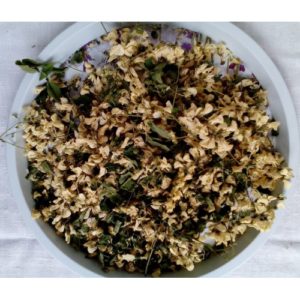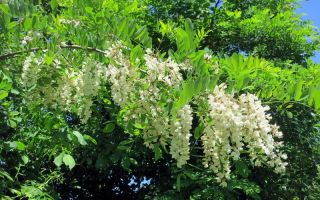Content
- 1 What does acacia look like and where does it grow?
- 2 The chemical composition of acacia flowers
- 3 Useful properties of acacia
- 4 What diseases does acacia help
- 5 Is acacia good for weight loss
- 6 Acacia-based traditional medicine recipes
- 7 Acacia essential oil in aromatherapy
- 8 Harm of acacia and contraindications for use
- 9 Collection, harvesting and storage of acacia
- 10 Conclusion
- 11 Reviews
Acacia is a large tree with fragrant flowers. There are several types of this plant. In Eurasia, the most common is white acacia or robinia. Its leaves and flowers are used for making tea, infusion and other medicinal products. The beneficial properties and contraindications of acacia have long been known in folk medicine. The plant is effective for the prevention and treatment of diseases.
What does acacia look like and where does it grow?
Acacia is a genus of plants in the legume family. It is found in Africa, Australia, Mexico, Europe and Asia. It looks like a shrub or tree up to 25 m high. It is a fast-growing tree, resistant to drought. It is planted for decorative purposes and to create protective forest plantations.
White acacia is mistakenly called another plant - robinia. She belongs to the genus Robinia and comes from North America. In Europe, it has been cultivated since the 18th century. The tree prefers moist calcareous soils, has a strong root system and grows quickly.
White acacia reaches 20-25 m in height, trunk diameter - 1 m. Shoots glabrous or slightly pubescent, color from olive to reddish-brown. The crown is openwork, spreading, cylindrical in shape. The root system branches well and extends 12-15 m deep. The crown is strong, gray-brown, with grown vertical cracks.
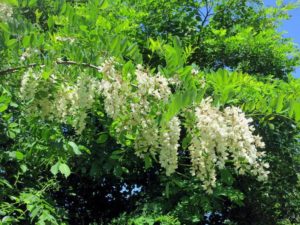
Robinia leaves are light green, alternate, pinnate, 10 to 45 cm long. At the base there are 2 cm long thorns, which can be easily broken off. Leaves are elliptical, 4 cm long and 2 cm wide.
In May-July, the white acacia produces drooping clusters 10-20 cm long. Each of them contains 5-15 buds. Calyx bell-shaped, 10 mm high, pubescent with short hairs. Corolla of white or cream shade, 3.5 cm in diameter. At the end of September, seeds ripen in the beans.
The chemical composition of acacia flowers
The benefits of white acacia are due to its chemical composition. The inflorescences and bark contain robinin. This substance is involved in the elimination of urea from the body. Also, drugs are obtained from it.
The leaves and flowers contain essential oils, flavonoids, glycosides, tannins, pectins, organic acids, minerals, vitamins A and C. Fatty oils are found in the fruits, their concentration reaches 15%.
Useful properties of acacia
Buds and bark have useful properties. The healing properties of acacia seeds are not fully understood, but the content of toxic substances has been confirmed. Therefore, a decoction or infusion of robinia seeds is easy to poison and harm the digestive system.
The healing properties of acacia flowers
- improve blood clotting;
- dilate blood vessels and relieve spasms;
- increase the production of phlegm with a cold;
- reduce body temperature;
- increase the secretion of sweat;
- destroy pathogenic bacteria;
- produce a diuretic effect;
- normalize blood pressure;
- stimulate the secretion of bile;
- lower the acidity of the stomach.
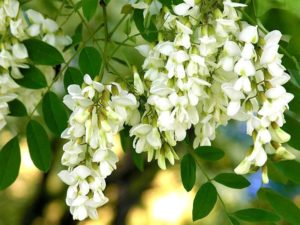
The properties of acacia wood are used in shipbuilding, for the construction of poles, fences, bridges and barns. This durable tree is less susceptible to pests and does not swell in water. The texture is rough but decorative. Robinia is difficult to process, so it is not used to make furniture.
What diseases does acacia help
The healing properties of acacia are used to treat a number of diseases:
- colds and viral infections;
- stomach diseases associated with high acidity;
- radiculitis;
- kidney and bladder damage;
- cystitis, thrush;
- osteochondrosis;
- varicose veins, thrombophlebitis;
- hypertension;
- skin ulcers.
Is acacia good for weight loss
The slimming benefits of acacia flowers have not been proven. To combat obesity, use other products from this plant. Robinia honey has a rich composition, removes toxins and toxins, cleanses the body, and helps to absorb fats. It is added to the diet instead of sugar.
White acacia honey has a high calorie content - 327 kcal per 100 g of product. In order not to harm the figure, it is recommended to eat 1 tbsp. l. honey before consuming carbohydrate foods or at night before bed.
Acacia-based traditional medicine recipes
The beneficial properties of acacia are used in folk medicine. Various parts of the plant are added to infusions and decoctions.
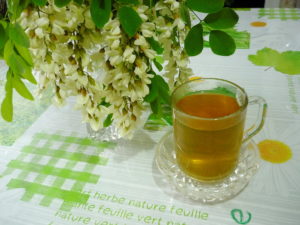
Infusion of acacia flowers
One way to use acacia flowers is to make an infusion. The remedy helps with diseases of the kidneys, genitourinary system, cystitis.
To prepare the infusion, you need:
- fresh or dry buds - 1 tsp;
- boiling water - 1 glass.
The raw material is placed in a cup and poured over with boiling water. Cover the top with a lid or plate. The infusion is left for 2 hours, then filtered through a sieve or gauze. The remedy will be beneficial if 1/3 cup is drunk daily before meals.
Alcoholic tincture of acacia flowers
An alcoholic infusion is prepared from the buds of acacia. The beneficial properties of white acacia help relieve joint pain, sciatica and rheumatism. 50 g of raw materials are poured into 0.5 liters of alcohol or vodka. The bottle is placed in a dark place and protected from direct sunlight. Periodically, the contents of the container are shaken.
The finished tincture is rubbed twice a day. The benefit of the procedure is that pain goes away, inflammation and swelling decrease.
When taken internally, the tincture benefits the nervous system: it improves sleep and relieves fatigue. 750 ml of vodka requires 500 g of dry buds. The tincture is kept for 3 weeks in a dark place, then filtered. Take 1-2 tsp daily before dinner. tinctures.
Acacia inflorescence broth
For stomatitis and periodontal disease, a decoction is prepared from robinia buds. Its beneficial properties will help relieve inflammation and heal wounds on the mucous membrane. With a cold, the broth gives an antipyretic effect and promotes the discharge of phlegm.
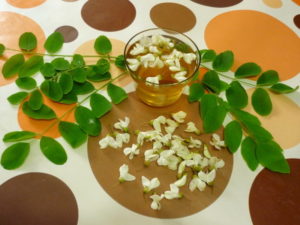
For 1 glass of boiling water add 1 tbsp. l. dried flowers. When the broth cools down, the raw material is filtered and used for gargling with sore throat. The benefit of such a remedy is to relieve fever in case of a cold. Without harm to health, the broth is taken 1/3 cup three times a day before meals.
For the treatment of gynecological diseases, a useful broth is taken three times a day for 1 tbsp. l. The course is 1 month. It is recommended to prepare a new broth every 1-2 days, since its benefits are lost with long storage.
Acacia tea
Robinia inflorescences are added to tea. It is taken for colds, women's diseases, kidney and stomach problems. Also, the healing properties of acacia tea are used for prostatitis. In general, the drink benefits the entire body: it strengthens the immune system, relieves anxiety and depression, and calms the nervous system.
1 cup of boiling water requires 1 tbsp. l. raw materials. Add honey or sugar to taste.Other herbs can also be used to make tea - mint, lemon balm, sage, rose hips.
Acacia flower tea is beneficial and harmful to the body if the intake is not followed. It is taken 2-3 times a day for 1 glass. Take a break every 2 months. The intake of healthy tea is resumed after 2-3 months.
Acacia flower juice
Useful juice is obtained from robinia inflorescences. In spring, on a dry day, the buds that have not yet blossomed are collected. 1 kg of raw materials requires 100 g of sugar. The components are mixed and transferred to an enamel container, well sealed and covered with a lid. The container is placed in the refrigerator for 10-14 hours. Then the raw material is squeezed through cheesecloth or sieve.
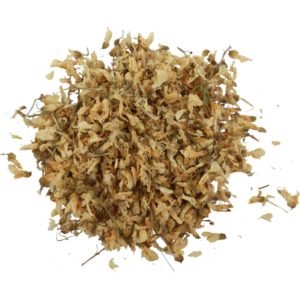
96% alcohol is added to the resulting liquid. 10 parts juice requires 1 part alcohol. 70% alcohol is needed 1.5 times more. The tool is placed in the refrigerator for a week. At first, the extract is green and rather cloudy, but over time it will turn light brown. A dark sediment may precipitate at the bottom, the benefits of the extract are not lost from this.
The beneficial properties of acacia extract are used for kidney diseases. The remedy relieves pain. The extract is taken three times a day for 1 tsp. half an hour before meals. Pain and other unpleasant symptoms disappear within 20 minutes.
Acacia bark tincture
The acacia tree bark also brings health benefits. It is added to alcoholic tinctures. The resulting product helps with stomach ulcers, effectively combats sciatica, rheumatism and varicose veins.
For 100 g of alcohol or vodka add 1 tbsp. l. chopped bark. The components are mixed and left warm for 2 weeks. Shake the mass periodically. The finished tincture is filtered. The rate of intake without harm to health is 10 drops an hour before meals, no more than 3 times a day. The general course of treatment is from 2 to 3 weeks.
For maximum benefit, the bark is infused with burdock root... 100 g of alcohol requires 1 tbsp. l. of each ingredient. The intake rate without harm to the body is 1 tbsp. l. an hour before meals. The procedure is repeated twice a day. The course of treatment is 18 days.
Alcohol tincture is useful for radiculitis and rheumatism. First, it is heated to 30 ° C and gently rubbed into the affected area in a circular motion.
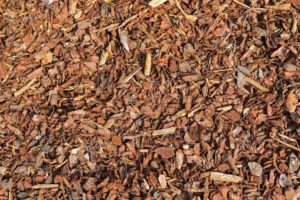
Acacia bark decoction
A useful broth is obtained on the basis of the robinia bark. It is taken for ulcers, gastritis and other gastrointestinal diseases. The broth is also used to prevent diseases associated with the work of the stomach and intestines.
Add 1 tbsp to a glass of boiling water. l. chopped bark. For the greatest benefit, also add 2 tbsp. l. burdock root and chamomile. The broth is infused for a day, then the liquid is filtered from the solid particles. The resulting product is taken in the amount of 1/3 cup 30 minutes before meals. The period of treatment without harm to health is 2 weeks. The procedure is repeated after 2 months.
Acacia essential oil in aromatherapy
The essential oil is obtained from Whitish and Farnese Acacia. The product has a dark yellow or brown color, a viscous consistency and a spicy aroma. In aromatherapy, this oil helps to get rid of nervous tension, improves sleep, restores strength, relieves fatigue and headache.
To obtain perfume compositions add oil of bergamot, violet, mimosa ylang-ylang.
The essential oil is used in cosmetology. It is added to skin cleansers and toners. As a result, turgor improves, wrinkles are smoothed, complexion improves, peeling and redness disappear.
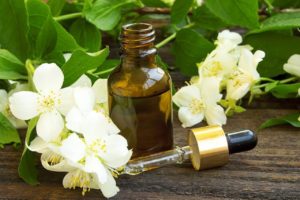
Harm of acacia and contraindications for use
Harm and contraindications of acacia flowers:
- pregnancy and breastfeeding;
- low stomach acidity;
- hypotension;
- individual intolerance.
The harm of robinia is explained by the content of toxic substances. They cause poisoning if the dosage is violated.If the drugs cause dizziness, headache, nausea or diarrhea, then stop taking. Children are given acacia for colds, flu and stomatitis. The infusion is used to rinse the throat or inside before eating.
Collection, harvesting and storage of acacia
Robinia inflorescences are harvested in May. The most beneficial are buds that have not yet opened. The bark is removed from young trees.
The collection is not carried out in rainy weather. The raw materials are left to dry in the fresh air or indoors. In order for the buds to retain their beneficial properties, they are placed in a cloth or paper bag and kept in a dark place.
Conclusion
The beneficial properties and contraindications of acacia are used in folk medicine. Decoctions and tinctures are prepared from buds and bark. Means help with various diseases of internal organs
